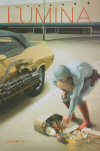Lumina – 2013
You will need a pen and paper for this one. Two columns. Two Nobel laureates. Two radically different approaches to prose. In the first column, we have Faulkner and the Gospel of John. In the second column, we have Hemingway and the architectural concept that form follows function. Many journals published today feature prose that ascribes to one camp more than the other. But Lumina seems to capture the two styles precisely down the middle. The balance is perfect: in the fiction column, we have three of each and two that cross camps. In the nonfiction column, we have twenty-five percent Faulkner, seventy-five percent Hemingway (which makes sense considering he was a journalist with a night job), one excellent satire, and one chiseled memoir of sex and acid in the 1980s.
You will need a pen and paper for this one. Two columns. Two Nobel laureates. Two radically different approaches to prose. In the first column, we have Faulkner and the Gospel of John. In the second column, we have Hemingway and the architectural concept that form follows function. Many journals published today feature prose that ascribes to one camp more than the other. But Lumina seems to capture the two styles precisely down the middle. The balance is perfect: in the fiction column, we have three of each and two that cross camps. In the nonfiction column, we have twenty-five percent Faulkner, seventy-five percent Hemingway (which makes sense considering he was a journalist with a night job), one excellent satire, and one chiseled memoir of sex and acid in the 1980s.
Molly Tolsky’s short fiction “Sugar Chest” meets criteria of both camps in a haunting and familiar cadence. In the spirit of Faulkner, she creates a moving meditation on abandonment. But while the subplot may be abstract, the objects and story line are palpable. She assembles the accoutrements of realism—we have a Capote-like cat and a Carver-like diction, but then she topples the strictly realist exercise with the same mystique that she began with: “I’m the house sitter for a family that’s never coming back.”
The other short fiction that most skillfully crossed the divide was Benjamin Schaefer’s horrific “Canning.” I have never read such artful pacing. The narrative was strictly realistic, with each pop of a jar or chilling “angel” dialogue conveyed in detail and order. But the tension and concept are more surreal than I think the Hemingway camp could stomach. You could certainly suspect “A Rose for Emily” to be on Schaefer’s shelf.
You could argue that Sam Martone’s short fiction “Last Tour” and Steven Ramirez’s “Este Pendejo Real Attack Death Video Free” toe the line too—their voices are brave and arresting and yet anchor their tales to brisk storytelling. Martone’s exploration of The Museum of Mourning is an inventive break from the how-to explosion and shows a lot of courage to make the story work as successfully as it does. Ramirez explores a different journey, and the reader must engage with it wholeheartedly as one would do with Faulkner and the Modernists—the benefit is tremendous, and the story is best when unpacked critically.
Another blisteringly intelligent story was Leah Schelbach’s short fiction “Bracelet.” In this issue of Lumina, George Saunders comments that Schelbach’s story was a “thoughtful and beautifully written examination of the way that religion . . . can affect human interactions.” Schnelbach is not just tackling a forgotten topic, she’s showcasing an intellectual dilemma that is rich with possibility.
In terms of blending genres, an imaginative pairing early in the journal is Marin Sardy’s nonfiction story “He Is Our Father” with Joe Ponepinto’s fiction “Nixon in State.” In Brittany Baker’s interview with David Shields, with excellent foreshadowing from the latter writings, Shields says: “Any work trapped in genre conventions feels to me very unlikely to capture human consciousness and human behavior in 2013.” This is exactly why Sardy’s and Ponepinto’s pieces are so outstanding. Neither one is limited by their genres—stylistic sleights and fantastic detail make one as likely to belong to one or the other. And because Lumina’s editors did not differentiate between fiction and nonfiction except in the table of contents, the reader must suspend disbelief on both counts and forge on.
In a related vein, Meg Thompson’s essay “Me and My Misophonia” is an incisive satire of medical memoirs. She explores all of the aches and pains of this sub-genre in perfect metaphor. For every labored interaction with a spouse and gradual coming-of-age emotionally with a “condition,” she has a witty realization, part of a portrait of the profound and ridiculous.
In conclusion, there were two pieces of literature that I prized especially: Janic Erlbaum’s nonfiction article “Utopia” and John Fenlon Hogan’s poem “Susurrus.” Erlbaum writes,
You used to be able to smoke in diners . . . the chewy, vegetal state of the unlit cigarette, the sulfur flash, then the acrid singe against your soft tissue. The smoke wending its way gorgeously through your veins, all the lights turning green, the avenues splitting into smaller and smaller streets until your fingertips buzzed.
You can feel it through every synapse. And Hogan begins, “To whomever or whatever, however it may concern” and carries through to, “I had theories for raindrops.” It’s like Ashbery, only somehow closer to your heart’s chambers.
Lumina is a showcase of some of the best writing in an American press. Its balance and beauty resonate beyond a classification or an estimation or a statistic. A living word, it resonates across the page.
[luminajournal.com]





